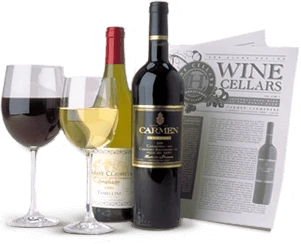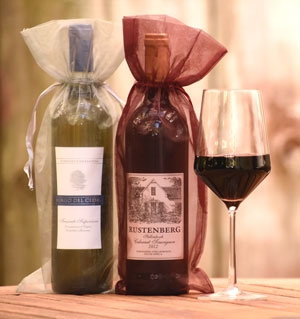A deep impenetrable robe is the first indication that the 2003 Château Belle-Vue Haut-Médoc is no ordinary Bordeaux. And the wine's flamboyant, almost exotic bouquet confirms the hypothesis. Reminiscent of top-notch Margaux or even Pomerol in this vintage, the 2003 Château Belle-Vue captivates the nose with scents of wild berries, crème de cassis, scorched earth, and lush woodlands. On the palate this warm, flavorful claret unfolds slowly and methodically, but the end result makes it well worth the wait. Lush, smooth, well-integrated flavors conjure the essences of blackberry, coffee, and vanilla as they glide harmoniously across the palate. They are followed by a wave of sweet tannins, transfused with mocha and plum. Although gentle and hedonistic from the moment the cork exits the bottle, the 2003 Château Belle-Vue is persistent on the palate and never misses a beat. Just give it some time to breathe (an hour is not too long) and you will be well rewarded. Gently and without fanfare, this charming well-balance claret works its magic. Anticipated maturity: 2008-2012.
Given the gentle, sophisticated nature of the 2003 Château Belle-Vue, our favorite accompaniments with this charming Haut-Médoc are simple, artfully prepared meals that are long on natural taste and short on heat or strong, spicy flavors. Consequently, a rotisserie chicken or an herb-grilled breast of chicken provides an ideal background with which to highlight this wine. Chicken Barigoule, a rotisserie fried chicken breast with braised artichokes, garlic, pearl onions, carrots, asparagus, and tomatoes, offers an especially tasty accompaniment to the finesse and subtlety of the 2003 Château Belle-Vue. Veal and pork tenderloin present other wonderful gastronomic opportunities with this superbly crafted Haut-Médoc. An assortment of French cheeses that includes Cantal, Port Salut, or even a young Camembert, while offering an excellent alternative to meat, proffers yet another splendid way to enjoy the 2003 Château Belle-Vue; but this wine hardly needs accompaniments to please. Unlike many young red Bordeaux, the 2003 Château Belle-Vue is a pleasure to sip on its own. A votre santé!
Château Belle-Vue is a 22-acre gem of an estate. It is one of several superb, recently renovated Haut-Médoc châteaux that are producing wines equal to classified growths. In recent years this diminutive property has collected well-deserved press and numerous accolades for its suave, sophisticated Margaux style wine. The success of this property serves as a reminder of just how fine the wines from well-situated, carefully run cru bourgeois Bordeaux châteaux can be, especially in a hot vintage such as 2003.
Until 1996, what is now Château Belle-Vue was part of Château de Gironville, and all of Belle-Vue's vines went into the production of Château de Gironville. Situated on a plateau of deep well-drained gravel 7-10 meters deep, Château Belle-Vue lies adjacent to the great Château Giscours and the Margaux appellation. Since renovating Belle-Vue's cellars and bottling the wine under its own label, Château Belle-Vue has distinguished itself by garnering numerous honors and medals at France's most prestigious wine competitions.
Given Château Belle-Vue's formidable terroir, grapes ripen early at this chateau – a distinct advantage in most vintages. Consequently, Cabernet Sauvignon is the dominant variety in the vineyard, but Château Belle-Vue also holds the distinction of growing perhaps the highest percentage of Petit Verdot of any Médoc château. In a vintage such as 2003, Petit Verdot shines; it complements Cabernet Sauvignon and adds polish and subtle complexity to the grand vin. Enjoy!
Bordeaux: The World's Most Renowned Wine
Bordeaux is the world's largest fine wine-producing region, encompassing more than 500,000 acres and dozens of individual appellations and communes. Communes such as Margaux, Pauillac, and St. Emilion are legendary, as are the scores of collectible wines that flow from their vineyards. Indeed, the wine wares of Bordeaux (both the region and its wines are referred to as Bordeaux) are some of the finest and most expensive on earth. Furthermore, this renowned viticultural region, which has become synonymous with full-bodied red wine, is also the traditional home of Cabernet Sauvignon, Merlot, and Cabernet Franc, the three musketeers of almost all red Bordeaux and the basis for Meritage blends around the world. Malbec, Petit Verdot, and even Carmenère are other red Bordeaux varietals that figure into the cepage or blend of at least some Bordeaux châteaux. And what remains unknown to many consumers is that Bordeaux is also one of the planet's largest and greatest sources of white wine, principally from Sauvignon Blanc and Semillon.
Bordeaux, meaning beside the waters, refers to the region's proximity to the Atlantic Ocean and the broad estuary, the Gironde, for which the entire viticultural department (the equivalent of a county or state in the United States) is named. Bordeaux, the region as well as the department's leading city, lies at the center of the confluence of the Dordogne and Garonne Rivers, which flow into the Gironde, which redoubles Bordeaux's effort to live up to its name. Moreover, it is Bordeaux's propinquity to the sea that provides a stable, moderate climate, which is favorable to the production of fine wine. This marriage to the sea has also provided the historical highway by which Bordeaux wines have traveled the world, gaining esteem and recognition long before most other landlocked wine regions were able to safely transport their wines overland to eager markets.
Since the first century BCE, when the Romans established themselves in Bordeaux and referred to the area as Biturigiaca, this ancient viticultural paradise has been a constant source of fine wine. Known to the emperors of Rome, poets (most notably Pliny and Ausonius), and popes, Bordeaux has enjoyed the envy of the wine-producing world longer than any other wine region on earth. From Pliny to the most contemporary wine critics, including Robert Parker Jr., Bordeaux wines have never gone out of favor. Besides, what other wine region can claim three millennia of continuous production and millions of satisfied customers?

Enjoy Limited Production Estate
Bottled Wines
Discover limited production estate bottled wines such as Vergenoegd's internationally
acclaimed 2005 Cabernet Sauvignon, imported exclusively for our members.


